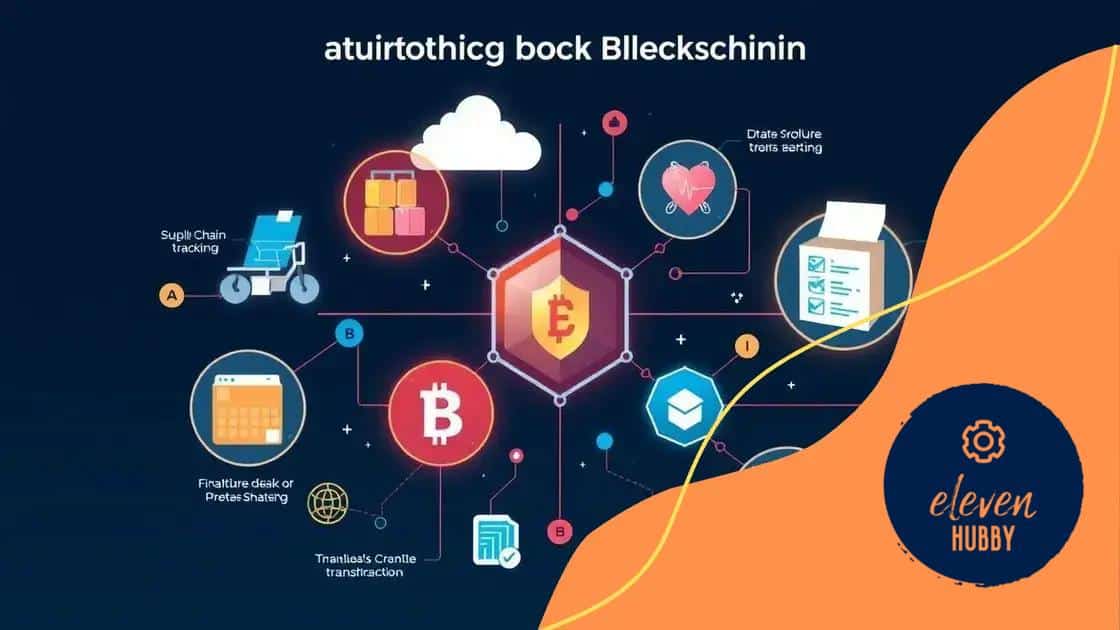Blockchain’s role in creating transparent supply chains

Blockchain’s role in creating transparent supply chains involves secure tracking of products, enhancing efficiency and trust through real-time monitoring and immutable records, while also meeting consumer demands for accountability and ethical practices.
Blockchain’s role in creating transparent supply chains is becoming increasingly vital. Have you ever wondered how this technology impacts the products you buy? Let’s unpack this fascinating topic.
Understanding blockchain technology
Understanding blockchain technology is crucial in today’s digital world. It serves as the backbone for many innovations, especially in supply chains. So, what exactly is blockchain? Think of it as a digital ledger that records transactions in a secure, transparent way.
How Does Blockchain Work?
At its core, blockchain is a series of blocks linked together. Each block contains individual transaction data, a timestamp, and a unique code called a hash. This system ensures that the information is secure and immutable, meaning it cannot be altered.
Key Features of Blockchain Technology
- Decentralization: Unlike traditional databases, information is stored across multiple locations, making it less vulnerable to attacks.
- Transparency: All transactions can be viewed by authorized users, ensuring accountability.
- Security: The use of cryptographic techniques protects the data within the blockchain.
Moreover, this technology provides a way to verify the authenticity of transactions without needing a central authority. For instance, in supply chains, each step can be tracked, ensuring that products are genuine and sourced ethically.
Understanding blockchain also means recognizing its impact on different industries. For instance, in healthcare, patient records can be securely shared among professionals without compromising privacy. In finance, faster cross-border transactions can be accomplished with reduced costs.
Challenges in Comprehending Blockchain
Despite its benefits, some individuals find blockchain difficult to understand. The technical jargon can be overwhelming, and misconceptions often arise. However, with simple explanations and real-world examples, the basic principles can be grasped.
Ultimately, grasping the foundational elements of blockchain technology is essential for appreciating its role in creating transparent supply chains. As you explore further, you’ll discover how this innovation transforms industries and can lead to more efficient business practices.
Benefits of blockchain for supply chains
The benefits of blockchain for supply chains are numerous and transformative. This technology helps enhance efficiency, transparency, and security, making it an essential tool for modern businesses.
Greater Transparency
One of the biggest advantages of blockchain is its ability to provide clear visibility throughout the supply chain. Every transaction is recorded on a public ledger, allowing all parties to view the data. This transparency fosters trust among buyers and suppliers.
Improved Traceability
Blockchain enables businesses to trace the origin of products easily. In case of disputes or issues, companies can quickly identify where a problem occurred. This capability is particularly valuable in industries like food and pharmaceuticals, where safety is crucial.
- Real-time tracking: Stakeholders can monitor product movements in real-time.
- Quick verification: Authenticity can be verified within moments.
- Reduced fraud: The immutable nature of blockchain deters potential scams.
Additionally, blockchain enhances operational efficiency by automating processes that are usually manual. Smart contracts, for example, execute automatically when conditions are met, reducing the need for intermediaries.
Cost Reduction
Using blockchain can lower costs by minimizing errors and streamlining operations. Fewer intermediaries mean reduced fees and faster transactions. Companies can save thousands of dollars by adopting this technology.
Moreover, with enhanced security features, the risk of data breaches and fraud diminishes significantly. Businesses can safeguard sensitive information, leading to greater confidence among customers.
As technology continues to evolve, more companies will recognize the benefits of blockchain for supply chains. By embracing this innovation, organizations can not only strengthen their operations but also gain a competitive edge in the marketplace.
Real-world applications of blockchain

Real-world applications of blockchain span across various industries, showcasing its versatility and effectiveness. Businesses worldwide are increasingly adopting this technology to enhance operations, improve security, and streamline processes.
Supply Chain Management
One of the most significant uses of blockchain is in supply chain management. Companies can track products from origin to consumer, ensuring transparency and accountability. With real-time tracking, stakeholders can see the journey of a product, reducing the risk of fraud.
Healthcare
In healthcare, blockchain is transforming patient data management. Medical records can be securely shared among providers while maintaining patient privacy. This technology also aids in tracking drug supply chains, ensuring that medications are legitimate and safe.
- Improved patient care: Doctors access up-to-date records easily.
- Enhanced data security: Reduces the risk of data breaches.
- Streamlined clinical trials: Enhances the integrity of clinical trial data.
Finance is another area where blockchain shines. With its ability to facilitate secure transactions, banks are exploring how it can improve cross-border payments, making them faster and more cost-effective. Using blockchain, companies can eliminate intermediaries, resulting in reduced transaction fees.
Voting Systems
Another exciting application is in voting systems. By using blockchain, votes can be securely cast and counted, making elections more transparent and less vulnerable to tampering. This innovation could restore trust in electoral processes globally.
Furthermore, blockchain is making waves in the entertainment industry for copyright management. Artists can protect their intellectual property directly through the blockchain, ensuring they receive fair compensation for their work.
As more organizations recognize the potential of blockchain, we can expect to see even more innovative applications emerge. Embracing this technology not only enhances operational efficiency but also fosters trust among consumers.
Challenges in blockchain implementation
Challenges in blockchain implementation can pose significant obstacles for organizations looking to adopt this innovative technology. While the benefits are clear, potential hurdles need careful consideration and strategic planning.
Scalability Issues
One major challenge is scalability. As more users join a blockchain network, the system may become slower. This lag happens because transactions need to be verified by multiple nodes. Increasing speed while maintaining security is still a work in progress.
Integration with Existing Systems
Many companies face difficulties integrating blockchain with their current systems. This integration requires not only technical adjustments but also changes in company processes. Employees may need training to use the new technology effectively. Resistance to change can also be a barrier.
- High initial costs: Setting up a blockchain system can be expensive.
- Technical expertise: Companies often lack the necessary skills in-house.
- Data privacy concerns: Sharing information on a public blockchain raises privacy issues.
Moreover, regulatory uncertainty is a significant obstacle. As governments and organizations develop policies, businesses may hesitate to adopt blockchain if they are unsure about future regulations. Clear guidelines are needed to build confidence in using this technology.
Security Vulnerabilities
Even though blockchain is known for its security features, vulnerabilities still exist. Smart contracts can contain bugs that malicious actors could exploit. Companies must carefully audit their systems before deployment to minimize risks.
Additionally, public perception of blockchain technology can impede progress. Misunderstandings and negative portrayals in the media might cause hesitation among stakeholders. Educating the public about blockchain’s true potential is essential.
Future trends in supply chain transparency
Future trends in supply chain transparency are shaping how companies operate. As technology advances, businesses are finding new ways to enhance openness and accountability.
Increased Use of Blockchain Technology
One of the most significant trends is the increased use of blockchain technology. Businesses are adopting blockchain for its ability to provide a secure and transparent way to track products. This technology helps in verifying the authenticity of items throughout the supply chain.
Integration of IoT in Supply Chains
The integration of the Internet of Things (IoT) is also transforming supply chain transparency. IoT devices enable real-time monitoring of products in transit. This capability allows companies to gather data about the condition and location of goods.
- Improved tracking: Sensors can provide updates on temperature, humidity, and movement.
- Faster response times: Companies can quickly react to discrepancies or issues.
- Enhanced visibility: Stakeholders gain deeper insights into the supply chain.
Furthermore, artificial intelligence is playing a key role in analyzing data from blockchain and IoT devices. AI can help predict demand, optimize routes, and identify potential risks. This data-driven approach enhances decision-making and increases operational efficiency.
Consumer Demand for Transparency
As consumers become more aware of sustainability and ethical practices, they are demanding greater transparency from companies. Businesses that can provide detailed information about their supply chains are likely to gain customer trust and loyalty.
Additionally, regulatory pressures are pushing firms to adopt transparent practices. Governments around the world are implementing stricter guidelines to ensure companies disclose their supply chain information fully.
Overall, the future of supply chain transparency is bright. With the right technology and commitment to openness, companies can build stronger relationships with customers and partners while enhancing their operations.
Conclusion
In conclusion, the evolving landscape of supply chain transparency is driven by technological advancements and changing consumer expectations. The integration of blockchain, IoT, and AI is vital in making supply chains more transparent, efficient, and secure. As companies embrace these innovations, they not only improve operations but also foster trust and loyalty among consumers. Staying ahead of trends is essential for businesses that want to thrive in the future.
| Key Topics | Details |
|---|---|
| 🔗 Blockchain | Ensures secure tracking and verification of products. |
| 📡 IoT Integration | Allows real-time monitoring and improved visibility. |
| 🤖 AI Applications | Analyzes data for better decision-making and efficiency. |
| 🌍 Consumer Demand | Increased demand for transparency and ethical practices. |
| ⚖ Regulatory Changes | Governments pushing for stricter transparency guidelines. |
FAQ – Frequently Asked Questions about Blockchain’s Role in Creating Transparent Supply Chains
What is blockchain technology?
Blockchain is a digital ledger that records transactions securely and transparently, allowing for real-time tracking of products across supply chains.
How does blockchain improve supply chain transparency?
By providing a secure and immutable record of transactions, blockchain allows all parties to verify the authenticity and movement of products easily.
What role does IoT play in supply chain management?
IoT devices enable real-time monitoring of goods, providing valuable data about their condition and location during transit.
Why is consumer demand for transparency increasing?
Consumers are becoming more aware of ethical practices and sustainability, requiring companies to provide clear information about their supply chains.






